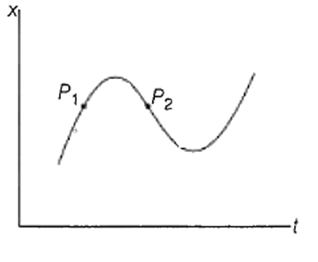 Multiple Choice Questions
Multiple Choice QuestionsUnder the action of a constant force, a particle is experiencing a constant acceleration. The power is
zero
positive constant
negative constant
increasing uniformly with time
D.
increasing uniformly with time
Instantaneous power is P = F.v = F.at
As force & acceleration are constant. So, velocity of the particle must be keep on increasing. Hence, power is increasing uniformly with time.
i.e. P ∝ t
A comet orbits around the Sun in an elliptical orbit. Which of the following quantities remains constant during the course of its motion ?
Linear velocity
Angular velocity
Angular momentum
Kinetic energy
Consider a satellite moving in a circular orbit around Earth. If K and V denote its kinetic energy and potential energy respectively, then (Choose the convention, where V = 0 as r → ∞)
K = V
K = 2V
V = − 2K
K = − 2V
Assuming the mass of Earth to be ten times the mass of Mars, its radius to be twice the radius of Mars and the acceleration due to gravity on the surface of Earth is 10 m/s2. Then the acceleration due to gravity on the surface of Mars is given by
0.2 m/s2
0.4 m/s2
2 m/s2
4 m/s2
The semi-major axis of the orbit of Saturn is approximately nine times that of Earth. The time period of revolution of Saturn is approximately equal to
81 years
27 years
729 years
The x-t plot shown in the figure below describes the motion of the particle, along x-axis, between two positions A and B. The particle passes through two intermediate points P1 and P2 as shown in the figure

The instantaneous velocity is positive as P1 and negative at P2.
The instantaneous velocity is negative at both P1 and P2
The instantaneous velocity is negative at P1 and positive at P2
The instantaneous velocity is positive at both P1 and P2
A ball falls from a table top with initial horizontal speed V0. In the absence of air resistance,which of the following statement is correct.
The vertical component of the acceleration changes with time
The horizontal component of the velocity does not change with time
The horizontal component to the acceleration is non zero and finite
The time taken by the ball to touch the ground depends on V0
A man of mass 60 kg climbed down using an elevator.The elevator had an acceleration 4 ms-2. If the acceleration due to gravity is 10 ms-2, the man's apparent weight on his way down is
60 N
240 N
360 N
840 N
A uniform rod of length of 1 m arid mass of 2 kg is attached to a side support at O as shown in the figure. The rod is at equilibrium due to upward force T acting at P. Assume the acceleration due to gravity as 10 m/s2 . The value of T is

0
2 N
5 N
10 N
CO− ion moving with kinetic energy of 20 keV dissociates into O− and C which move along the parent ion direction. Assuming no energy is released during dissociation, the kinetic energy of the daughters (K.E)O and (K.E)C are related as
(K.E)O− = (K.E)C
(K.E)O− / (K.E)C = 16/12
(K.E)O− / (K.E)C = 12/16
(K.E)O− / (K.E)C = 16/28
